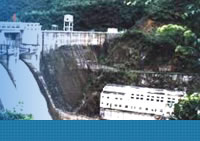Xu Zeping
(China Institute of Water Resources and Hydropower Research)
[Abstract] On May 12, 2008, a strong earthquake with 8.0 Richter scale jolted Wenchuan County in Sichuan Province of China. More than 60,000 people were killed. Zipingpu concrete faced rockfill dam, which is only 17 km away from the epicenter, was survived from the earthquake. But it is also suffered severe damages during the strong earthquake. By conducting the dam site inspection immediately after the earthquake, the paper presents the damages and the performance of Zipingpu CFRD during the earthquake. Preliminary safety assessment was also concluded in the paper.
1.Introduction
On May 12 2008, a strong earthquake hit Wenchuan County in Sichuan Province of China at 2:28 pm, killing more than 60,000 people. The quake measured 8.0 on Richter scale, with the epicenter located at 31.0 degree north latitude and 103.4 degree east longitude, according to the State Seismological Bureau (SSB) of China. The earthquake occurred beneath the steep eastern margin of the Tibetan plateau, where is also the west edge of Sichuan Basin. The rupture occurred over a length of 270 km along a north-northeast striking, west dipping to steep fault beneath and parallel to the northeast striking Longmenshan trust belt. The rupture plane and the aftershock sequence extend northeast of Longmenshan range, as shown in Figure 1.

Figure 1 Epicenter and aftershocks of Wenchuan earthquake、
Sichuan province locate at southwestern part of China, where is rich in water resources and hydropower resources. It is the most important hydropower energy base of China. Many hydro projects and hydropower projects are constructed or under construction in this area. Near the epicenter, there are four major large dams, e.g. Zipingpu concrete faced rockfill dam, Shapai RCC dam, Bikou central core rockfill dam and Baozhushi concrete gravity dam. As Zipingpu CFRD is the only high CFRD that sustained such a strong earthquake until now, the investigation of the performance of the dam during the strong earthquake will provide valuable knowledge of the behavior of CFRD.
2.General features of Zipingpu CFRD
Zipingpu hydro project is located at Dujiangyan city, upstream of Minjiang River, 60 km northwest of Chengdu, the capital of Sichuan Province. The main purposes of the project are water supply and power generation. The total storage of the reservoir is 11?108m3 and the installed capacity is 760 MW. The main dam is a concrete faced rockfill dam with the height of 156 m. The elevation of dam crest is 884 m. The upstream slope of the dam is 1:1.4. The downstream are designed with two slopes to ensure the stability of dam crest during earthquake. The upper part of the downstream slope is 1:1.5 and the lower part of the downstream slope is 1:1.4. The typical dam section is shown in Figure 3.
According to the original earthquake intensity map, the basic earthquake intensity of the dam site area is VII. The designed earthquake intensity is VIII, with the peak ground acceleration of 0.26g. The distance from Zipingpu CFRD to the epicenter is 17 km.
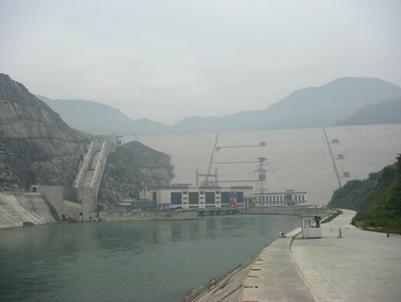
Figure 2 Zipingpu concrete faced rockfill dam
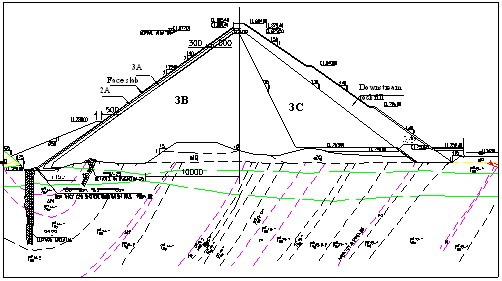
Figure 3 Typical dam section
3.General safety status of the dam
During the earthquake, the accemerogram recorded at the center of dam crest is shown in Figure 4. It can be noticed that the acceleration at dam crest has reached 2g. Considering the normal amplification factor, the ground acceleration should be larger than 0.5g, which is far more beyond the intensity accepted by the design.
After careful inspection of the dam immediately after the earthquake, Zipingpu CFRD is considered structurally stable and safe. But the dam do sustained a range of damages during the quake, including cracks at the top and collapsed workshop.
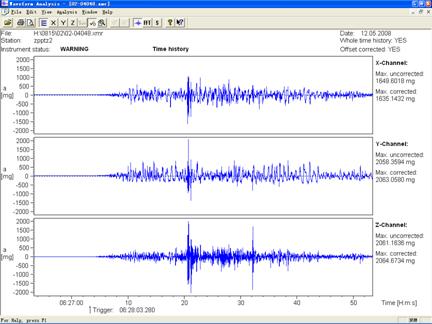
Figure 4 Accemerogram recorded at the center of dam crest
4.Performance of the dam during earthquake
During the construction, numerous monitoring instruments were installed. The strong earthquake has damaged some of the instruments. But most of the instruments are still in good operation. Those instruments have provided valuable information of the dam performance during the quake.
4.1 Dam deformation
During the earthquake, significant deformation was occurred on the dam. Immediately after the earthquake, an obvious settlement of dam crest in riverbed section could be identified even by eye view (Figure 5). From the measurement of the mark points of dam crest, dam crest has a significant settlement in the moment of earthquake. The maximum settlement value is 683.9 mm and it is located at the river center section. After the main earthquake, the observed settlement of dam crest still developed. But the rate of settlement dropped rapidly. On May 12, the maximum settlement of dam crest reached to 744.3 mm. On May 22, the settlement of dam crest was basically stable. The maximum displacement of dam crest in the direction of river flow is 199.9 mm, towards downstream direction. The position of the maximum displacement located at riverbed section. For the displacement in the direction of dam axis, the rockfill of abutment areas are trend to move to the center of the river. The maximum horizontal displacement towards right abutment is 226.1 mm and the maximum horizontal displacement towards left abutment is 106.8 mm.
From the observed data of the settlement inside the dam, it can be noticed that the settlements of rockfill are increased with the rising of elevation. Higher elevation presents more deformation and settlement. On EL. 760 m, the settlement at dam axis due to the earthquake is 106.0 mm. On EL. 820 m, the settlement at dam axis is 322.5 mm. On EL. 850 m, the settlement at dam axis is 810.3 mm.
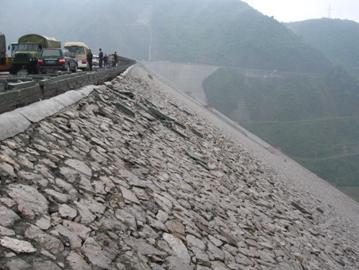
Figure 5 Settlement of dam crest
During the earthquake, the downstream part of rockfill dam has a relatively larger displacement. On El. 766 m, El. 795 m, El. 824 m and El. 854 m, the observed horizontal displacement towards downstream direction are 69.8 mm, 166.9 mm, 260.5 mm and 274.4 mm respectively. The observed maximum horizontal displacement towards downstream direction at dam crest is 199.9 mm. So there is a big crack along the downstream side of the crest road (as shown in Figure 6).
4.2Concrete face slab
The strong earthquake has produced certain damage on concrete face slab, which include the cracks and ruptures of the face slab. On El. 845 m, where is the construction joint of the second stage face slab and third stage face slab, the face slabs are overlapped (as shown in figure 7). The height of the overlapping is 150 mm?170 mm and the reinforcement across the joint is bended into “Z” shape.
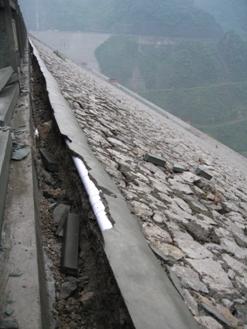
Figure 6 Crack at the downstream side of dam crest
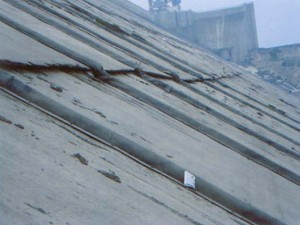
Figure 7 The overlapping of the second stage and third stage face slabs
Along the vertical joint of the face slab 5 and 6 (left abutment) and the face slab 23 and 24 (riverbed), concrete face slabs were ruptured by the action of large compression stress along dam axis. From figure 8, the spalling of concrete can be noticed.
By drilling detection, large areas of the upper part of concrete face slab are separated with rockfill. The maximum value of the gap between face slab and rockfill at the top of the third stage face slab at left abutment is 230 mm. The maximum value of the gap at the top of second stage face slab at right abutment is 70 mm.
4.3 Parapet wall
As the maximum dynamic response of the dam occurred at dam crest, the quake caused many cracks and ruptures of the parapet wall. Near the abutment, the originally closed joints were opened. In riverbed section, the parapet wall was ruptured by large compression stress (as shown in Figure 9).
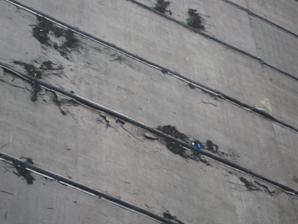
Figure 8 Rupture of concrete slabs along vertical joint
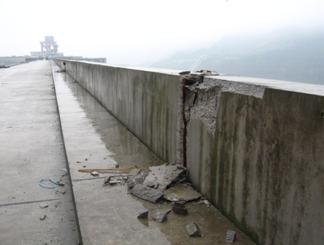
Figure 9 Rupture of parapet wall in riverbed section
4.4 Primetric joint
During the earthquake, primetric joints have produced relatively large displacement. Some of the installed instruments were damaged. In some points, the displacements are beyond the measuring limit of the instrument. According to the available data, the measured displacements of the primetric joint at left abutment (El. 833) are: 92.85 mm of settlement, 57.85 mm of opening displacement and 13.42 mm of shearing displacement. As a comparison, the displacements at the same position before the earthquake are: 1.59 mm (settlement), 11.99 mm (open) and 4.67 mm (shear).
4.5 Leakage
The leakage observation of the dam is shown in Figure 10. It can be noticed that the dam leakage has a close relationship with reservoir water level. Before the earthquake, the leakage of the dam is 10.38 L/s (May 10). After the earthquake, the leakage of the dam was increased to 19 L/s. The first two days of after earthquake, the seepage water was turbid. Now the seepage water becomes clear.
5.Concluding remarks
From the performance of Zipingpu CFRD during the strong earthquake, the concluding remarks can be drawn as follows:
(1) The May 12 Wenchuan earthquake has a very strong scale and very high density. As a high CFRD near the epicenter, Zipingpu CFRD is the only CFRD that sustained such a strong earthquake. Although the quake has produced severe damage on the dam, the dam is still structurally stable and safe. It has been proven that the design of the dam is rational and the construction quality is good.
(2) The performance of Zipingpu CFRD during the strong earthquake has demonstrated the safety features of CFRD during earthquake. As there is no serious slide of downstream slope, it shows that the two stage slope design (1:1.5 for the upper part slope and 1:1.4 for lower part slope) for downstream slope is appropriate
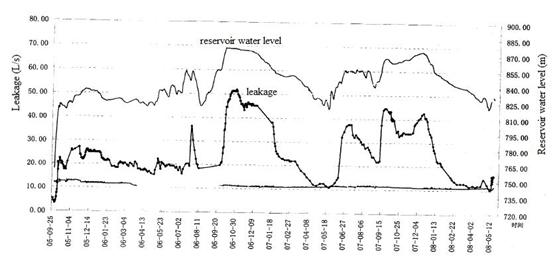
Figure 10 Leakage of the dam
(3) As the maximum dynamic response of the dam during the earthquake mainly focus at dam crest, the damages are occurred on the upper part of the dam. The forms of damage of CFRD during earthquake presented by the performance of Zipingpu CFRD can be summarized as: settlement of upper part rockfill, downstream slope movement, spalling of parapet wall, cracks and rupture of concrete face slab, gaps of face slab and rockfill, etc. For the case of Zipingpu CFRD, the waterstop system is not seriously damaged. It has no significant increase of dam leakage. But it should be noticed that waterstop system is one of the vulnerable part of CFRD upon extreme load case. Careful structure design and good construction quality should be guaranteed.

